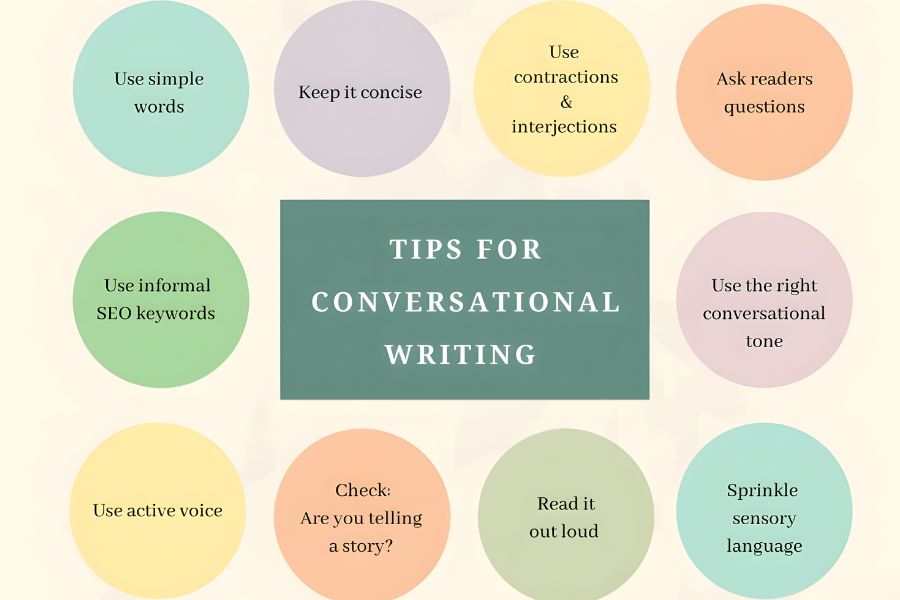Conversational Writing Techniques: Engage and Connect with Your Audience
In the digital age, where content is abundant, making your writing stand out is crucial. One effective way to achieve this is through conversational writing techniques. This style, which mimics how people speak in everyday conversation, can make your content more engaging, relatable, and ultimately more impactful.
Understanding Your Audience
The first step in mastering conversational writing techniques is understanding your audience. Who are they? What are their interests, preferences, and pain points? Knowing your audience allows you to tailor your tone and language to resonate with them. For instance, writing for teenagers will differ significantly from writing for business professionals. By aligning your writing style with your audience’s expectations, you create a connection that keeps them engaged.
Key Elements of Conversational Writing Techniques

Conversational writing techniques involve several key elements:
- Simple and Clear Language: Avoid jargon and complex words. The goal is to communicate your message as clearly and straightforwardly as possible.
- Contractions and Colloquial Expressions: Use contractions (like “you’re” instead of “you are”) and everyday phrases to make your writing sound more natural.
- Rhetorical Questions: Asking questions engages readers and makes them think, fostering a sense of dialogue.
- Anecdotes and Personal Stories: Sharing stories makes your writing more relatable and helps illustrate your points in a memorable way.
Techniques for Engaging Conversational Writing
To make your writing engaging, start by addressing the reader directly using “you.” This approach makes the reader feel involved and creates a personal connection. A friendly and approachable tone is essential. Think of your writing as a conversation with a friend rather than a formal lecture.
Using active voice instead of passive voice can make your writing more dynamic and clear. For example, “You can improve your writing” is more direct and engaging than “Your writing can be improved.”
Breaking down complex ideas into digestible pieces is another effective conversational writing technique. Use short sentences and simple words to explain intricate concepts. Additionally, varying your sentence length and structure creates a natural flow that mirrors spoken language, making your writing more pleasant to read.
Enhancing Readability
Enhancing readability is crucial in conversational writing techniques. Use bullet points and lists to break up information and make it more scannable. Incorporate white space and keep paragraphs short to avoid overwhelming the reader with large blocks of text. Adding headings and subheadings not only helps with navigation but also provides visual breaks that make the content more approachable.
Examples of Conversational Writing Techniques
To see conversational writing techniques in action, look at popular blogs, articles, and social media posts. These platforms often feature writing that is engaging, approachable, and effective. Analyse how the authors use conversational techniques to connect with their readers. Notice the use of simple language, personal anecdotes, and rhetorical questions that invite readers into a dialogue.
Common Mistakes to Avoid
While conversational writing techniques are effective, it is essential to avoid common pitfalls. Overuse of jargon and technical terms can alienate readers who are not familiar with the subject matter. Being overly informal or unprofessional can undermine your credibility, especially in more serious contexts. While conversational writing can be more relaxed, it is still important to follow basic grammar and punctuation rules to maintain clarity and professionalism.
Practical Tips for Writers
Here are some practical tips to help you improve your conversational writing techniques:
- Read Your Content Out Loud: Hearing your words can help you catch awkward phrasing and ensure your writing sounds natural.
- Seek Feedback: Ask peers or readers for feedback on your writing. They can provide valuable insights into how your content is perceived.
- Practice Continuously: Like any skill, conversational writing techniques improve with practice. Write regularly and experiment with different techniques to find what works best for you.
Parting Wisdom

At Write Ink, as a content writing agency, we know that conversational writing techniques are a game-changer for engaging and connecting with your audience. By keeping the language simple, speaking directly to the reader, and maintaining a friendly tone, we make your content feel more relatable and impactful. We’re all about avoiding common pitfalls and always honing our craft. With these techniques, Write Ink creates compelling narratives that truly resonate with your readers
Image Reference: Freepik
Disclaimer: All trademarks, logos, and brand names are the property of their respective owners. All company, product, and service names used in this website are for identification purposes only. Use of these names, trademarks, and brands does not imply endorsement.







